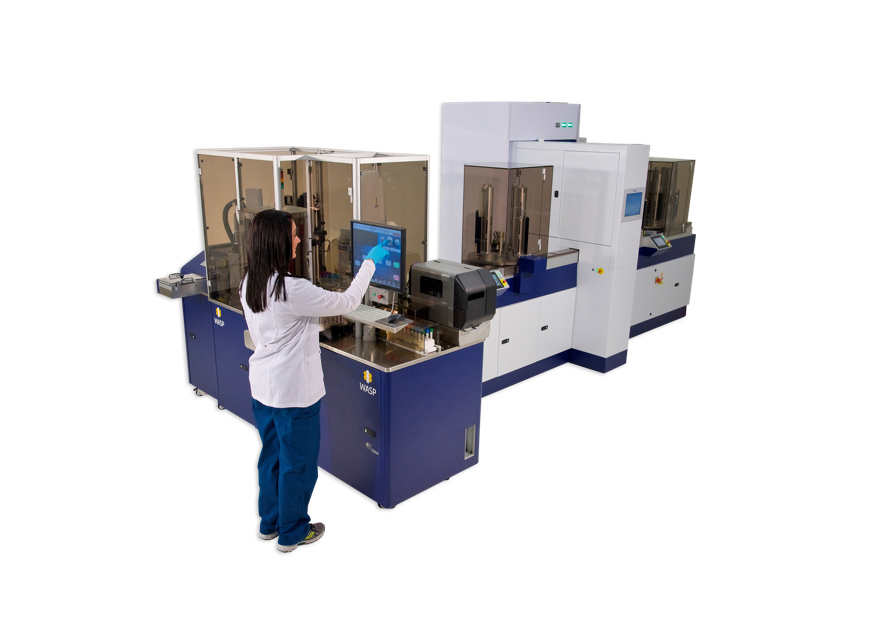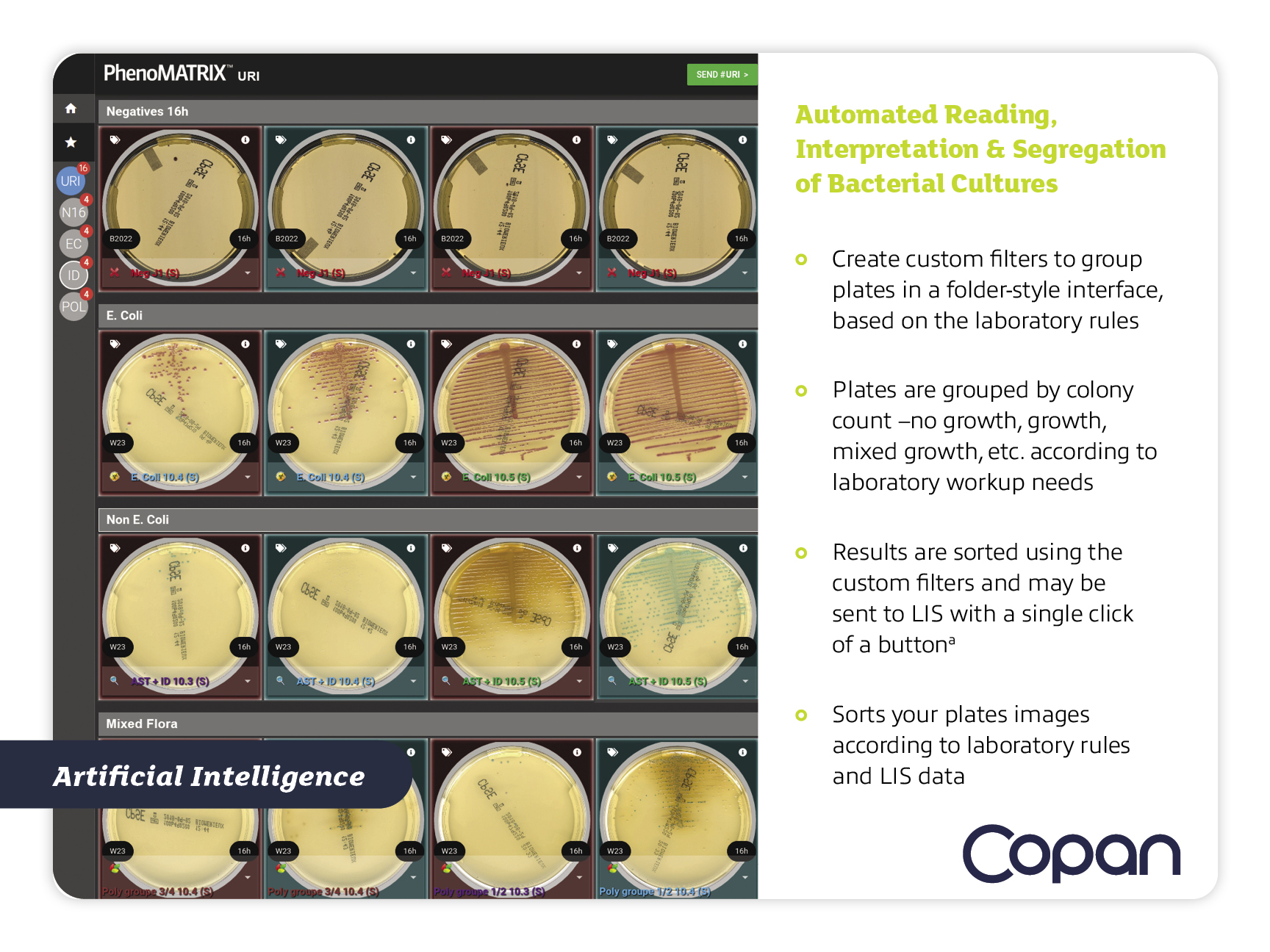Welcome to our latest blog post where we explore the transformative power of automation in the realm of clinical microbiology. As the world of healthcare continues to evolve, so too does the need for more efficient, accurate, and streamlined laboratory processes. Automation has been making waves in various clinical laboratory disciplines, and now, it’s becoming increasingly more prevalent in clinical microbiology.
In this post, we delve into a comprehensive article from the June 2023 edition of Clinical Laboratory News (CLN), titled “Understanding Laboratory Automation in Clinical Microbiology.” Authored by Dr. Do Young Kim, the article provides a detailed overview of the current state of Full Laboratory Automation (FLA), the challenges it faces, and the exciting potential it holds for the future.

We’ll provide a summary of the key points, and look at the implications of the article, related it to our Copan’s innovative automation solutions, including WASPLab® and PhenoMATRIX® AI software. Whether you’re a laboratory professional, a healthcare provider, or simply interested in the future of healthcare technology, the following will provide valuable insights into the exciting world of laboratory automation. Let’s dive in!

Article Summary
- Automation is increasingly being used in many clinical laboratory disciplines, including clinical chemistry, molecular biology, immunology, and hematology.
- Advances in technology and more centralized laboratory models have led to the development of Full Laboratory Automation (FLA) systems. These systems streamline workflows, optimize incubation conditions, improve sample tracking, and reduce errors and injuries.
- Automated specimen processors can inoculate liquid-based specimens onto solid agar media or broth media, reducing variability from manual plate streaking, minimizing cross-contamination, and reducing costs and time associated with specimen processing.
- Automated systems, like Copan’s WASPLab®, transport plates to an incubator with the appropriate atmospheric conditions, optimizing incubation conditions and enhancing bacterial growth.
- FLA Artificial Intelligence (AI) software, like Copan’s PhenoMATRIX®, allows laboratory staff to read and interpret digital images of plates and mark which colonies require further work up. PhenoMATRIX®, by Copan, uses algorithms to detect organisms of interest and can segregate cultures according to their growth, color, and morphology.
- Advances in machine learning and AI are expected to bring further developments to clinical microbiology laboratories.
In Depth Article Analysis
Automation is becoming a staple in many clinical laboratory disciplines, including clinical chemistry, molecular biology, immunology, and hematology. However, achieving “total” automation in clinical microbiology has been considered challenging due to factors such as the diversity of microbiological specimen collection sites, the complexity of their containers, the need to test for a large number of pathogens, and the high cost of automation relative to low specimen volumes.


Despite these challenges, advances in technology and more centralized laboratory models have led to the development of Full Laboratory Automation (FLA) systems. These systems have been implemented in many labs worldwide, offering the potential to streamline workflows, optimize incubation conditions, improve the ability to track samples, and reduce errors and repetitive stress injuries.

Two major commercially available systems are Kiestra by BD and WASPLab® by Copan. These systems automate specimen processing, reducing variability from manual plate streaking, minimizing cross-contamination, and reducing costs and time associated with specimen processing.
Once specimen processing is complete, these automated systems transport plates on a conveyor belt to an incubator with the appropriate atmospheric conditions. This process optimizes incubation conditions and enhances bacterial growth, including the emergence of rarely recovered and fastidious organisms.

FLA software allows laboratory staff to read and interpret digital images of plates and mark which colonies require further work up. PhenoMATRIX® Artificial Intelligence by Copan uses algorithms to detect organisms of interest, including methicillin-resistant Staphylococcus aureus (MRSA), vancomycin-resistant Enterococci (VRE), and group B streptococcus (GBS) on a chromogenic agar.

Implications of the Article:
The article underscores the importance and potential of automation in clinical microbiology. As the demand for testing increases and staff shortages become more prevalent, automation can provide a solution to these challenges. Automation can streamline workflows, reduce errors, and improve the quality of results.
For Copan, the article highlights the effectiveness of our WASPLab® system and PhenoMATRIX® AI software. These tools not only automate and streamline the laboratory process but also improve the accuracy of results by using advanced algorithms to detect organisms of interest.
To learn more about how automation can revolutionize your clinical microbiology lab, we invite you to read the full article. For more information on our WASPLab® system and PhenoMATRIX® software, we encourage you to explore our automation product pages.

Copan FLA: Full Laboratory Automation
At Copan Diagnostics, we are at the forefront of this automation revolution. Our Full Laboratory Automation (FLA) system and PhenoMATRIX® AI software are designed to streamline workflows, reduce errors, and improve the quality of results in clinical microbiology labs.
Find out more the entire suite of Copan’s Automation Here

WASPLAB® IS A HIGHLY EFFICIENT, MODULAR, SCALABLE AND CUSTOMIZABLE SPECIMEN PROCESSING AND CULTURE WORK-UP SYSTEM FOR CLINICAL MICROBIOLOGY. Samples move from front-end processing WASP®, to Smart Incubation, Digital Microbiology and Artificial Intelligence and Interpretive Algorithms for plate reading. Copan’s WASPLab® system automates specimen processing, reducing variability from manual plate streaking, minimizing cross-contamination, and reducing costs and time associated with specimen processing.

UNPARALLED IN THE INDUSTRY, PHENOMATRIX® USES ARTIFICIAL INTELLIGENCE COMBINED WITH CLINICAL INFORMATION FROM THE LIS with rules customized by the laboratory to automatically read, interpret, and sort bacterial cultures with the click of a button. Adding the PhenoMATRIX® suite of algorithms to WASPLab® automation system eases the interpretation of patient results and gives microbiology labs the ability to shorten their time to results.
Copan’s PhenoMATRIX® software uses advanced algorithms to detect organisms of interest, including MRSA, VRE, and GBS on a chromogenic agar. It can also segregate urine cultures according to their growth, providing a more efficient and accurate analysis.
[a] Subject to final reporting performed by qualified personnel.

